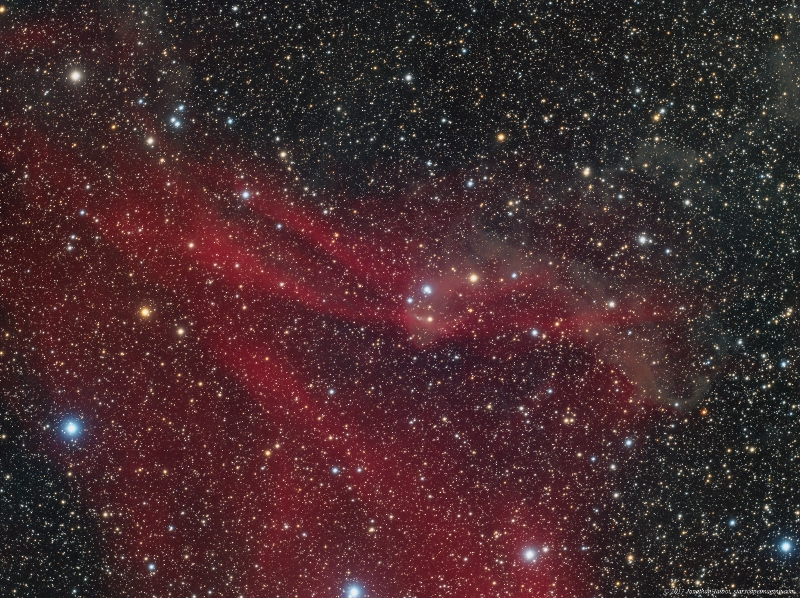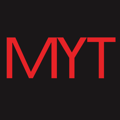
Larger size jpg images available here: 1920x1435, 1200x900, Full size: full size
Lynds Bright Nebula (LBN) 437 and surrounding area
About this object
This wide field image covers an area in the constellation Lacerta where the dense molecular cloud called LBN 437 resides. Its the dusty S shaped area that is opaque and brownish from near center and curving to the right. Near center and just below two blue stars is a young star called LkHa 233, a Herbig Ae/Be star. This star is also named V375 Lacerate and it displays a bipolar jet of material. A higher resolution view of this star with its bipolar jet and the entire molecular cloud can be seen here:V375 Lacertae. The large red emission area is a separate object from LBN 437 and is called Sh2-126. It’s very large and extends out of the field of view. This area is ionized and glows red due to the ultraviolet radiation from the hot star 10 Lacerate, which lies below the field of view.
This image is a composite image utilizing data from LRGB and Ha filters spanning close to 40hrs of exposure time. The image was processed in PixInsight.
This wide field image covers an area in the constellation Lacerta where the dense molecular cloud called LBN 437 resides. Its the dusty S shaped area that is opaque and brownish from near center and curving to the right. Near center and just below two blue stars is a young star called LkHa 233, a Herbig Ae/Be star. This star is also named V375 Lacerate and it displays a bipolar jet of material. A higher resolution view of this star with its bipolar jet and the entire molecular cloud can be seen here:V375 Lacertae. The large red emission area is a separate object from LBN 437 and is called Sh2-126. It’s very large and extends out of the field of view. This area is ionized and glows red due to the ultraviolet radiation from the hot star 10 Lacerate, which lies below the field of view.
This image is a composite image utilizing data from LRGB and Ha filters spanning close to 40hrs of exposure time. The image was processed in PixInsight.
Processing Steps:
This image was processing with PixInsight 1.8
Calibration: The batch preprocessing script was used to reduce and cosmetically correct the images. The corrected images were run through the blink tool to weed out the obviously bad images affected by clouds and then run through the subframe selector script to select the best subframes for further processing.
Registration and Integration: The selected images were then registered against a master using the registration tool and combined into master Luminance, Red, Green, Blue and Ha images using the image integration tool. Drizzle data was also output and the Drizzle tool was used to create the final LRGB and Ha master frames. This effectively doubled the resolution to near 1.6 arcsec/pix.
A synthetic Luminance image was produced combining the Luminance, Red, Green, Blue and Ha masters using the image integration tool with no rejection. The master frames were gradient corrected using the DBE tool and a RGB image was produced using the channel combination tool. The RGB image was run through the photometric calibration tool to correct the colors.
The RGB and Ha images were then combined using the NBRGB combination script using default values. The output HaRGB image was again run through the photometric color calibration tool with auto background neutralization.
Deconvolution: Deconvolution was used too slightly sharpen the master synthetic luminance image.
Noise reduction: Noise reduction was then performed on the linear Luminance and HaRGB images using the multi scale linear transform tool after which the images were stretched using the histogram tool. A second round of noise reduction was done on the stretched images using the TGV noise reduction tool using a mask to protect the bright high signal areas and stars.
The synthetic luminance and HaRGB image were combined using the LRGB combination tool.
Faint dust enhancement: The background enhancement script was used to produce a large scale and small scale (star) mask. The large scale mask was applied to the image and curves was used over several iterations to enhance the background dust. The histogram was adjusted with no clipping.
Color Saturation: Another range mask was created and used to select only the higher signal areas and omit the background. Curves were then used over several iterations to enhance the color saturation. The small scale star mask was then used to select only the stars. Curves was used again to increase the star color saturation.
Sharpening: A slight application of unsharp mask was used to slightly increase the sharpness of the stars and brighter objects in the image.
This image was processing with PixInsight 1.8
Calibration: The batch preprocessing script was used to reduce and cosmetically correct the images. The corrected images were run through the blink tool to weed out the obviously bad images affected by clouds and then run through the subframe selector script to select the best subframes for further processing.
Registration and Integration: The selected images were then registered against a master using the registration tool and combined into master Luminance, Red, Green, Blue and Ha images using the image integration tool. Drizzle data was also output and the Drizzle tool was used to create the final LRGB and Ha master frames. This effectively doubled the resolution to near 1.6 arcsec/pix.
A synthetic Luminance image was produced combining the Luminance, Red, Green, Blue and Ha masters using the image integration tool with no rejection. The master frames were gradient corrected using the DBE tool and a RGB image was produced using the channel combination tool. The RGB image was run through the photometric calibration tool to correct the colors.
The RGB and Ha images were then combined using the NBRGB combination script using default values. The output HaRGB image was again run through the photometric color calibration tool with auto background neutralization.
Deconvolution: Deconvolution was used too slightly sharpen the master synthetic luminance image.
Noise reduction: Noise reduction was then performed on the linear Luminance and HaRGB images using the multi scale linear transform tool after which the images were stretched using the histogram tool. A second round of noise reduction was done on the stretched images using the TGV noise reduction tool using a mask to protect the bright high signal areas and stars.
The synthetic luminance and HaRGB image were combined using the LRGB combination tool.
Faint dust enhancement: The background enhancement script was used to produce a large scale and small scale (star) mask. The large scale mask was applied to the image and curves was used over several iterations to enhance the background dust. The histogram was adjusted with no clipping.
Color Saturation: Another range mask was created and used to select only the higher signal areas and omit the background. Curves were then used over several iterations to enhance the color saturation. The small scale star mask was then used to select only the stars. Curves was used again to increase the star color saturation.
Sharpening: A slight application of unsharp mask was used to slightly increase the sharpness of the stars and brighter objects in the image.
Image Details
- Optics : Stellarvue SV 70T triplet refractor
- Mount: Paramount MYT
- Camera: QSI 583
- Filters: Astrodon Gen 2 LRGB+5nm Ha
- Exposure: HaLRGB: 1100:260:400:400:420 bin 1x1
- Camera/Mount Control: The Sky X, CCD Auto Pilot 5
- Guiding: Unguided using ProTrack
- Processing: PixInsight 1.8,
- Location: Stark Bayou Observatory, Ocean Springs, MS
- Date: Oct-Nov 2017




